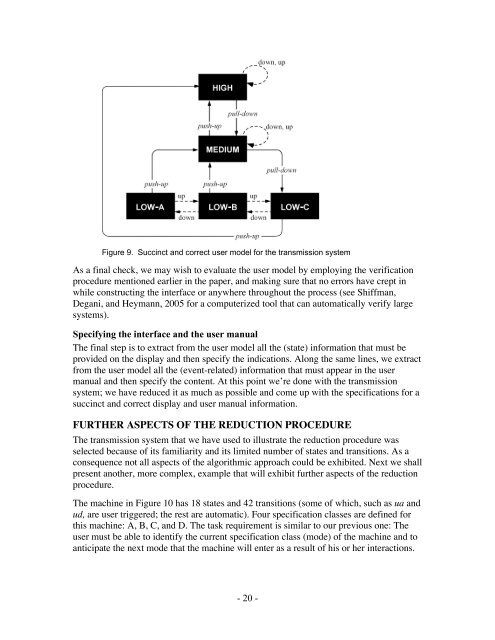formal analysis and automatic generation of user interfaces
formal analysis and automatic generation of user interfaces
formal analysis and automatic generation of user interfaces
Create successful ePaper yourself
Turn your PDF publications into a flip-book with our unique Google optimized e-Paper software.
Figure 9. Succinct <strong>and</strong> correct <strong>user</strong> model for the transmission system<br />
As a final check, we may wish to evaluate the <strong>user</strong> model by employing the verification<br />
procedure mentioned earlier in the paper, <strong>and</strong> making sure that no errors have crept in<br />
while constructing the interface or anywhere throughout the process (see Shiffman,<br />
Degani, <strong>and</strong> Heymann, 2005 for a computerized tool that can <strong>automatic</strong>ally verify large<br />
systems).<br />
Specifying the interface <strong>and</strong> the <strong>user</strong> manual<br />
The final step is to extract from the <strong>user</strong> model all the (state) information that must be<br />
provided on the display <strong>and</strong> then specify the indications. Along the same lines, we extract<br />
from the <strong>user</strong> model all the (event-related) information that must appear in the <strong>user</strong><br />
manual <strong>and</strong> then specify the content. At this point we’re done with the transmission<br />
system; we have reduced it as much as possible <strong>and</strong> come up with the specifications for a<br />
succinct <strong>and</strong> correct display <strong>and</strong> <strong>user</strong> manual information.<br />
FURTHER ASPECTS OF THE REDUCTION PROCEDURE<br />
The transmission system that we have used to illustrate the reduction procedure was<br />
selected because <strong>of</strong> its familiarity <strong>and</strong> its limited number <strong>of</strong> states <strong>and</strong> transitions. As a<br />
consequence not all aspects <strong>of</strong> the algorithmic approach could be exhibited. Next we shall<br />
present another, more complex, example that will exhibit further aspects <strong>of</strong> the reduction<br />
procedure.<br />
The machine in Figure 10 has 18 states <strong>and</strong> 42 transitions (some <strong>of</strong> which, such as ua <strong>and</strong><br />
ud, are <strong>user</strong> triggered; the rest are <strong>automatic</strong>). Four specification classes are defined for<br />
this machine: A, B, C, <strong>and</strong> D. The task requirement is similar to our previous one: The<br />
<strong>user</strong> must be able to identify the current specification class (mode) <strong>of</strong> the machine <strong>and</strong> to<br />
anticipate the next mode that the machine will enter as a result <strong>of</strong> his or her interactions.<br />
- 20 -

















